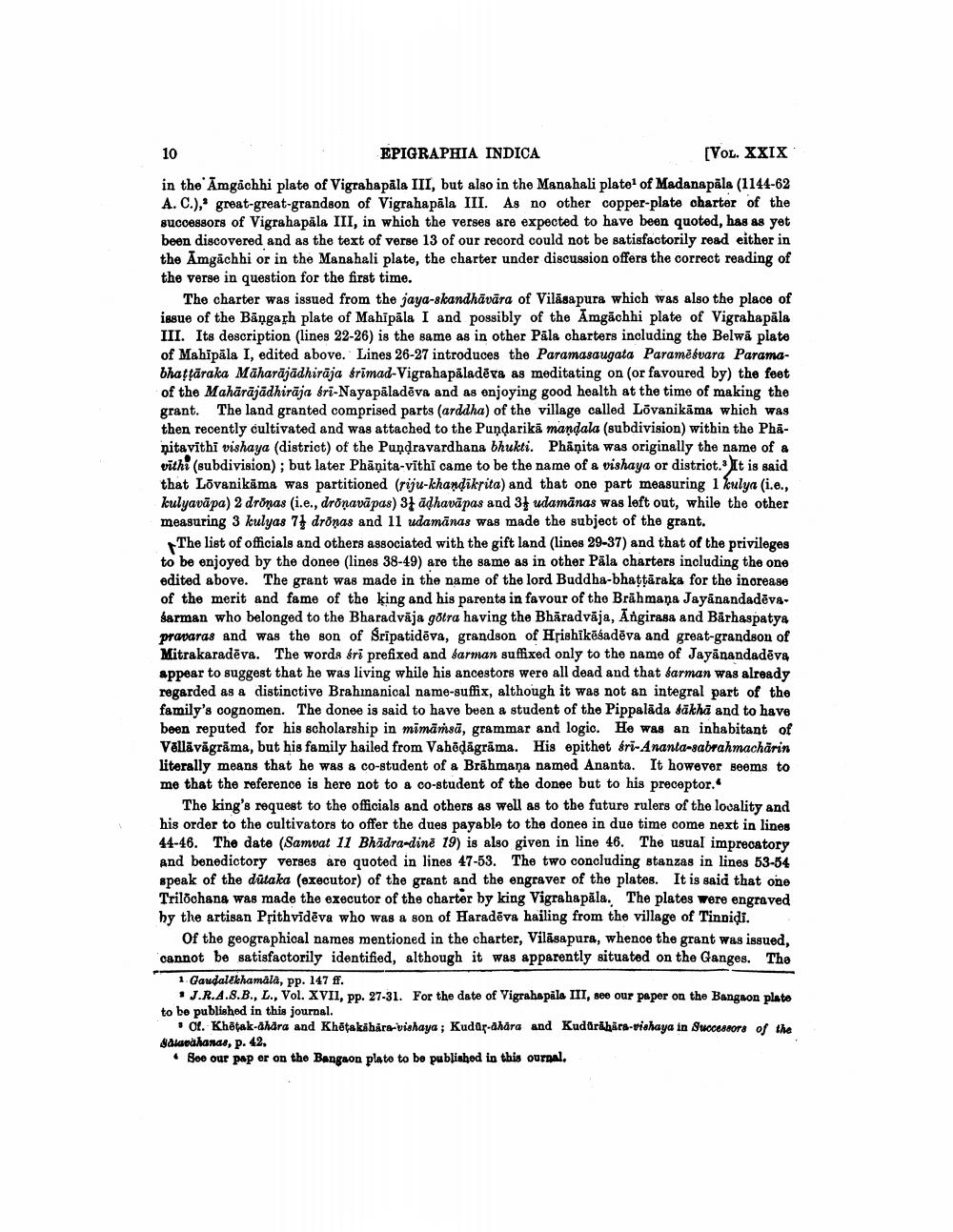________________
10 EPIGRAPHIA INDICA
[VOL. XXIX in the Amgachhi plate of Vigrahapāla III, but also in the Manahali plate' of Madanapāla (1144-62 A. C.), great-great-grandson of Vigraha pāla III. As no other copper-plate oharter of the successors of Vigrahapāla III, in which the verses are expected to have been quoted, has as yet been discovered and as the text of verse 13 of our record could not be satisfactorily read either in the Amgāchhi or in the Manahali plate, the charter under discussion offers the correct reading of the verse in question for the first time.
The charter was issued from the jaya-skandhāvāra of Viläsapura which was also the place of issue of the Băngah plate of Mahīpāla I and possibly of the Amgāchhi plate of Vigrahapāla III. Its description (lines 22-26) is the same as in other Pāla charters including the Belwā plate of Mahīpāla I, edited above. Lines 26-27 introduces the Paramasaugata Paramēšvara Paramabhattāraka Māharājādhiraja Srimad-Vigrahapaladēva as meditating on (or favoured by) the feet of the Mahārājādhirāja bri-Nayapāladēva and as enjoying good health at the time of making the grant. The land granted comprised parts (arddha) of the village called Lovanikāma which was then recently cultivated and was attached to the Puņdarikā mandala (subdivision) within the Phānitavithi vishaya (district) of the Pundravardhana bhukti. Phānita was originally the name of a vithi (subdivision); but later Phāṇita-vīthi came to be the name of a vishaya or district. It is said that Lõvanikāma was partitioned (riju-khandikrita) and that one part measuring 1 kulya (i.e., kulyavāpa) 2 drônas (i.e., drönavāpas) 37 adhavāpas and 31 udamānas was left out, while the other measuring 3 kulyas 74 drönas and 11 udamānas was made the subject of the grant.
The list of officials and others associated with the gift land (lines 29-37) and that of the privileges to be enjoyed by the donee (lines 38-49) are the same as in other Pāla charters including the one edited above. The grant was made in the name of the lord Buddha-bhattāraka for the increase of the merit and fame of the king and his parents in favour of the Brāhmaṇa Jayānandadēvssarman who belonged to the Bharadvāja gòtra having the Bhäradvāja, Angirasa and Bärhaspatya pravaras and was the son of Sripatidēva, grandson of Hrishikēšadēva and great-grandson of Mitrakaradēva. The words tri prefixed and farman suffixed only to the name of Jayānandadēva appear to suggest that he was living while his ancestors were all dead and that sarman was already regarded as a distinctive Brahinanical name-suffix, although it was not an integral part of the family's cognomen. The donee is said to have been a student of the Pippalāda sākha and to have been reputed for his scholarship in mimāṁsā, grammar and logic. He was an inhabitant of Vallāvāgrāma, but his family hailed from Vahôdāgrāma. His epithet éri-Ananta-sabrahmacharin literally means that he was & co-student of a Brāhmaṇa named Ananta. It however seems to me that the reference is here not to a co-student of the donee but to his preceptor.
The king's request to the officials and others as well as to the future rulers of the locality and his order to the cultivators to offer the dues payable to the donee in due time come next in lines 44-46. The date (Samvat 11 Bhadra-dine 19) is also given in line 46. The usual imprecatory and benedictory verges are quoted in lines 47-53. The two concluding stanzas in lines 53-54 speak of the dutaka (executor) of the grant and the engraver of the plates. It is said that one Trilochana was made the executor of the charter by king Vigrahapala. The plates were engraved hy the artisan Prithvidēva who was a son of Haradēva hailing from the village of Tinnidi.
Of the geographical names mentioned in the charter, Vilāsapura, whence the grant was issued, cannot be satisfactorily identified, although it was apparently situated on the Ganges. The
1. Gaudalekhamala, pp. 147 ff.
• J.R.A.S.B., L., Vol. XVII, pp. 27-31. For the date of Vigrahapala III, see our paper on the Bangaon plato to be published in this journal.
• Ol. Khotak-ahdra and Khētakähära-vishaya ; Kudar-ahāra and Kudüråhära-vishaya in Successors of the dalavahanas, p. 42,
• Soe our pop or on the Bangaon plate to be published in this ournal.




